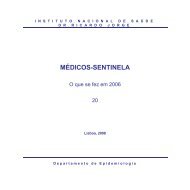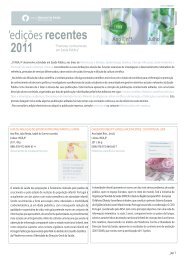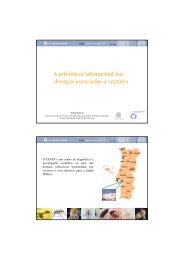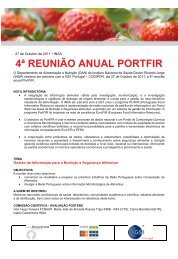European Society of Mycobacteriology - Instituto Nacional de Saúde ...
European Society of Mycobacteriology - Instituto Nacional de Saúde ...
European Society of Mycobacteriology - Instituto Nacional de Saúde ...
Create successful ePaper yourself
Turn your PDF publications into a flip-book with our unique Google optimized e-Paper software.
OP-9<br />
LAM AND HIV: CORRELATION OR CO-INCIDENCE?<br />
McNerney, Ruth, Mallard, Kim<br />
London School <strong>of</strong> Hygiene & Tropical Medicine<br />
The <strong>de</strong>adly synergy between TB and HIV presents a serious challenge to heath and <strong>de</strong>velopment. Three <strong>de</strong>ca<strong>de</strong>s after the<br />
onset <strong>of</strong> the AIDS pan<strong>de</strong>mic the region with the highest prevalence <strong>of</strong> HIV infection is sub-Saharan Africa, followed by<br />
the Caribbean and Latin America. Molecular typing methods permit differentiation <strong>of</strong> M. tuberculosis into strain families<br />
or genotypes. We have un<strong>de</strong>rtaken analysis <strong>of</strong> genotyping data to compare the prevalence <strong>of</strong> spoligotype lineage with<br />
that <strong>of</strong> HIV infection. Data was taken from the peer reviewed literature, surveys testing only drug resistant strains or<br />
those not fully <strong>de</strong>scribing the genotype population were exclu<strong>de</strong>d. The Latin-American-Mediterranean (LAM) lineage are<br />
i<strong>de</strong>ntified as typically lacking spoligotype spacers corresponding to oligonucleoti<strong>de</strong>s 21 to 24 and 33 to 36. They have<br />
been observed in many geographic locations and inclu<strong>de</strong> the F11 family reported in South Africa. Our analysis suggests<br />
that LAM strains are more frequently found in regions with a high prevalence <strong>of</strong> HIV. Conversely, they are rare in settings<br />
where HIV has yet to emerge as a major threat to public health. Interestingly LAM genotypes appear less frequent<br />
in African countries such as Uganda, Tanzania and Cameroon which have lower HIV prevalence’s than countries such as<br />
Malawi, Zimbabwe and South Africa where HIV rates are in excess <strong>of</strong> 10%. Why tuberculosis <strong>of</strong> this genotype should be<br />
linked to the HIV epi<strong>de</strong>mic remains a matter <strong>of</strong> speculation. Although socioeconomic and political factors play a significant<br />
role they do not explain the uneven distribution <strong>of</strong> HIV in sub Saharan Africa. It is now evi<strong>de</strong>nt that there is diversity<br />
in the interaction <strong>of</strong> M. tuberculosis with its host and strains <strong>of</strong> differing genotype appear to elicit subtle but significant<br />
differences in immune response. We present the hypothesis that strains <strong>of</strong> tuberculosis belonging to the LAM genotype<br />
are associated with enhanced transmission <strong>of</strong> TB in immunosuppressed populations.<br />
<strong>European</strong> <strong>Society</strong> <strong>of</strong> <strong>Mycobacteriology</strong> | 30 th Annual Congress | July 2009 | Porto - Portugal<br />
51

















